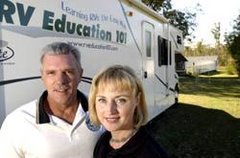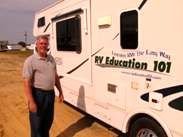After numerous requests we finally decided to produce a motorhome driving DVD. I enlisted the help from a professional driver and book author Lorrin Walsh. I always thought I was a good driver, but even old dogs can learn new tricks. Here are my top 7 tips to help improve your driving skills.
1. Know where your pivot point is and what it means. The pivot point is defined as the fixed point on a vehicle at which the vehicle rotates around in a turn. On a two-axle vehicle it is the center of the rear axle. This means that if an object, for example a tree, is located at the center of the rear axle or behind, you can turn toward the object and not hit it. If the object is ahead of the pivot point and you turn toward it, you will hit it.
2. Have an understanding of what off-tracking is and how it affects the way your coach turns. Off-tracking is the difference between the path of the front wheels and the rear wheels, during the course of a turn. You really don’t need to know how much your coach off-tracks; you just need to know what it is and how it affects the way your coach turns.
What is beneficial is to establish what Lorrin calls “turn offsets.” A turn offset is the distance that your coach will travel forward during a turn, in relationship to how far away you were from an object when you started the turn. It basically shows you how your coach turns. To establish your turn offsets, park your coach parallel to a line and 1 foot away (you can do this in a parking lot). Then mark the line adjacent to your pivot point. Now, turn the wheels full lock, or as far as they will turn in the direction of the line, and move forward until the pivot point you established on the coach intersects with the line. Measure the distance you have traveled from the starting mark that you put on the line, to the pivot point. This is your turn offset from 1 foot away.
It doesn’t hurt to take these measurements turning both left and right. This gives you an opportunity to see what it looks like in the mirrors, and not all vehicles turn the same in both directions. Repeat this exercise at two-, three-, and four-feet intervals from a parallel line. If you tow something behind your motorhome it’s a good idea to take it with you when you try this, to see where the towed vehicle crosses the line. Then you know what to expect when towing a vehicle.
3. Find out what your tail swing is. Tail swing is the distance that the body of the coach behind the pivot point moves in the opposite direction of the front when you turn. To establish what your tail swing is, stop your motorhome with the side of it parked along a straight line. Then, make a full lock turn away from the line and have someone measure the maximum swing as you turn. When we were filming, Lorrin’s motorhome had a tail swing of 18 inches, but another coach we tested had 30 inches of tail swing. In general, a newer motorhome chassis will turn more sharply, which equates to more tail swing.
4. After you have your turn offset and tail swing information you will know exactly what you need to do to properly setup for a maneuver. The setup is the most important part of any maneuver. Setup is how you position your motorhome to start a maneuver after taking all these other factors into consideration. By setting up farther away from the obstruction and starting to turn earlier, you would be able to turn into a much smaller lane or opening. Also, by knowing your tail swing you know at least how far to be from a wall or other objects before you start your turn. In traffic you will need to allow space in the lane on the opposite side from the direction that you are turning, for your tail to swing into. Something that really needs to be stressed here is don’t force a turn. If there is not enough room to make the maneuver, stop and wait for traffic to clear to complete your turn. And if it doesn’t look like there is enough room to make the maneuver, don’t do it!
5. Proper mirror adjustment is an important element to improving your driving skills. Approximately 30 percent of the hazards you will encounter come from the rear, so getting the maximum viewing area from your mirrors is critical. If you have the type of mirrors that extend out in front of your motorhome on long arms, make sure the inside edge of the mirror is flush with the side of the coach. When we were filming, we found that the majority of motorhomes with mirrors of this type were not set correctly.
The best way to check the mirrors is to stand in front of your coach and sight down the side. The inside of the mirror head should look like it is just touching the side of the coach. Having the mirror flush with the side of the coach gives you the best overall view. Some motorhomes taper in on the front and can give you a false setting, so make sure you are looking down the side. On the passenger side you should set the mirror flush with the outside of the awning arms. If the mirror is too far in or out, you are losing valuable viewing area. Adjust the flat part of the mirror so you can just see the side of your coach along the inside edge and so you are looking back level with the ground about one-fourth of the way from the top of the mirror. You really don’t need to see a lot of sky.
6. Establish reference points. In a car you have a hood in front of you to use as a sight, but in a motorhome you have very little in front of you to assist in staying on course. While you are at the parking lot to establish your turn data, park the motorhome with the driver’s side of the coach on a long line and see where that line intersects the bottom of the windshield. If there is no specific reference point, mark that spot with a piece of tape or other type of marker. Then move the coach, so the line is on the passenger side, and mark the windshield the same way. This will give you your limits. These marks will give your subconscious some help to stay centered in your lane and maintain a straight course. You should also note where your windshield marks or any reference points you have established on the dash are when centered on an average-width roadway.
7. Make sure other adults who travel with you are capable and confident in driving the motorhome, too. It’s better to share the driving duties or, at a minimum, have the ability to drive if the need presents itself.
These are simple driving tips you can apply to help improve your driving skills. I want to thank Lorrin Walsh for his contributions to this article. For more information on how to drive like a pro, check out Lorrin’s book or our Drive your Motorhome Like a Pro DVD
Happy RV Learning,
Mark Polk
RV Education 101
RV University
RV Orientation
Go for the RV Gold
Follow us on FACEBOOK
RV Consumer
Hi my name is Mark Polk
Mark & Dawn Polk

About
- Mark and Dawn Polk
- Mark Polk is a retired Army Chief Warrant Officer Three, specializing in wheeled and track vehicle fleet maintenance operations. In addition to owning and operating RV Education 101 since 1999, Mark also has a very extensive RV background working in RV sales, service and management. Dawn Polk is Mark’s wife and is RV Education 101’s Sales and Marketing director. After 3 years in RV sales, she left her position to help start RV Education 101. http://www.rveducation101.com
RV Training Products
Free Monthly RV 101 Newsletter
Visit our Sponsors
Copyright All Rights Reserved

We welcome you to LINK to this blog or any post within this blog. You may not copy the article in it's entirety and post. You may only use a small introduction of the material with an unaltered clickable link. Full attribution must be given by using UNALTERED CLICKABLE links in addition to giving FULL credit in plain view to Mark Polk and RV Education 101 with a SPECIFIC CLICKABLE link to the ORIGINAL content. You may not claim any of this content as your idea. Other unauthorized duplication and/or use of this material without the express written consent of Mark Polk is strictly prohibited.
Blog Archive



No comments:
Post a Comment